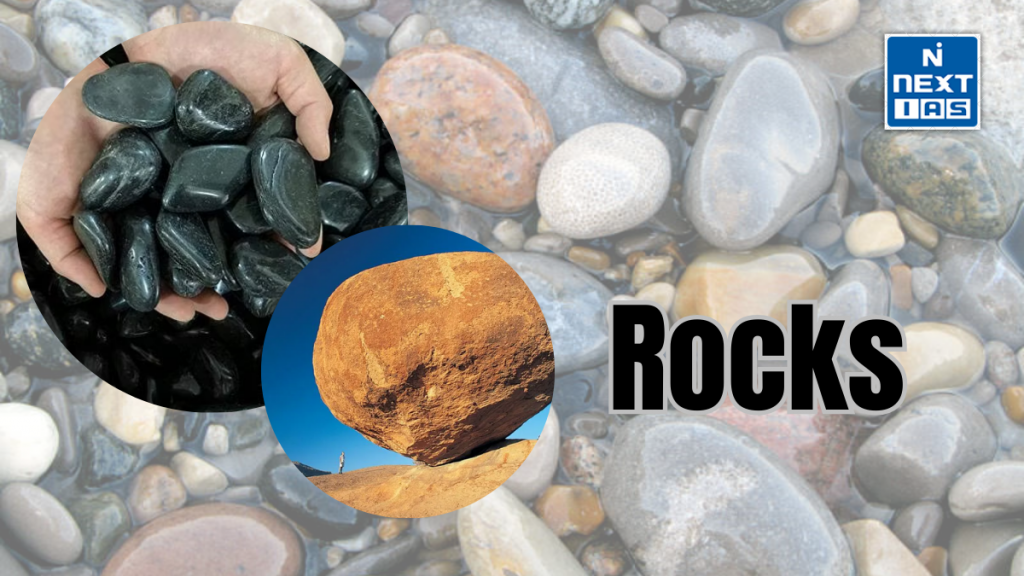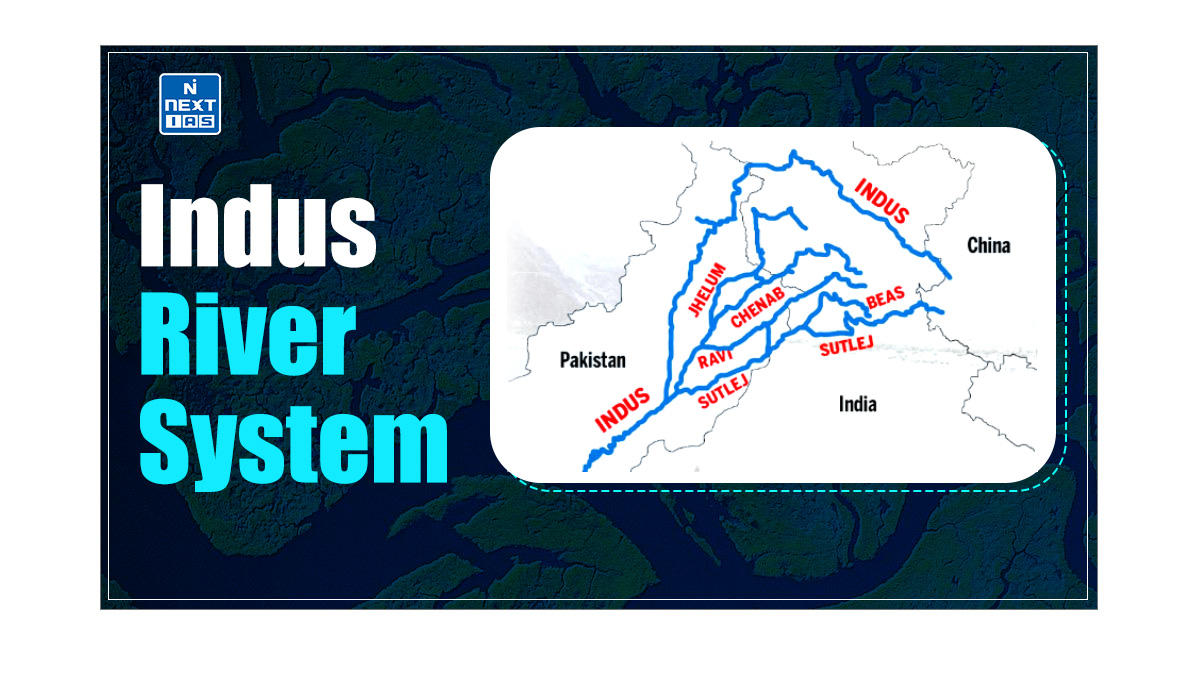
Rocks are solid, naturally occurring substances composed of minerals and organic materials. They form the Earth’s crust and are classified into three main types: igneous, sedimentary, and metamorphic. Rocks play a vital role in Earth’s geology, shaping landscapes and supporting ecosystems, and are essential for various human activities.
About The Rocks
- Rocks are naturally occurring solid substances composed of minerals, organic materials, or a combination of both. They form the Earth’s crust and play a key role in shaping the planet’s landscapes. Rocks are classified into three main types: igneous, sedimentary, and metamorphic.
- Igneous rocks form from the cooling and solidification of molten material, either magma beneath the Earth’s surface or lava during volcanic eruptions. Examples include granite and basalt.
- Sedimentary rocks are formed from the accumulation and compaction of sediments, such as sand, mud, and organic material, over time. Examples include limestone and sandstone.
- Metamorphic rocks result from the transformation of existing rocks under high pressure, temperature, or chemical processes. Examples include marble, which forms from limestone, and slate, which forms from shale.
- Rocks are essential to many geological processes, provide resources like minerals and fossil fuels, and influence soil formation. Their study helps in understanding Earth’s history and the processes shaping our planet.
Types of Rocks
Rocks are classified into three main categories based on their formation process: igneous, sedimentary, and metamorphic. Each type has distinct characteristics and plays a unique role in Earth’s geology.
Igneous Rocks
- Formation: Formed from the cooling and solidification of molten rock (magma or lava).
- Characteristics: Can be coarse-grained or fine-grained depending on how slowly or quickly the magma cools.
- Examples:
- Granite: A coarse-grained rock formed from slow cooling of magma deep underground.
- Basalt: A fine-grained rock formed from the rapid cooling of lava at the Earth’s surface.
- Obsidian: A naturally occurring volcanic glass formed from the rapid cooling of lava.
Sedimentary Rocks
- Formation: Formed from the accumulation, compaction, and cementation of sediments over time, such as sand, mud, or organic materials.
- Characteristics: Often have layers or strata and may contain fossils.
- Examples:
- Limestone: Formed mainly from calcium carbonate, often from the remains of marine organisms.
- Sandstone: Composed of sand-sized mineral particles, typically quartz.
- Shale: Formed from the compaction of fine clay particles.
Metamorphic Rocks
- Formation: Formed from the alteration of existing rocks (igneous, sedimentary, or other metamorphic rocks) under high pressure, temperature, or chemically active fluids.
- Characteristics: Often have a foliated or non-foliated texture and may show signs of mineral reorientation or new mineral growth.
- Examples:
- Marble: Formed from the metamorphism of limestone, characterized by its fine grain and ability to polish.
- Slate: Formed from the metamorphism of shale, commonly used for roofing.
- Schist: A foliated rock with large, visible mineral crystals.
Each rock type tells a different story about the Earth’s geological history, and their characteristics influence their use in construction, industry, and art.
Formation Process of Rocks
Rocks are formed through various geological processes, depending on their type. These processes are categorized into three main rock formation types: igneous, sedimentary, and metamorphic.
Igneous Rock Formation
- Process: Igneous rocks are formed from the cooling and solidification of molten material, either magma (beneath the Earth’s surface) or lava (on the Earth’s surface).
- Subtypes:
- Intrusive (Plutonic): When magma cools slowly beneath the surface, it forms large crystals. Examples: granite, diorite.
- Extrusive (Volcanic): When lava cools rapidly on the surface, it forms fine-grained or glassy textures. Examples: basalt, pumice, obsidian.
Sedimentary Rock Formation
- Process: Sedimentary rocks form from the accumulation, compaction, and cementation of sediments such as sand, clay, and organic materials. These sediments may come from pre-existing rocks, biological processes, or chemical precipitation.
- Subtypes:
- Clastic Sedimentary Rocks: Formed from fragments of other rocks (e.g., sandstone, shale).
- Chemical Sedimentary Rocks: Formed from the evaporation of water and precipitation of minerals (e.g., limestone, rock salt).
- Organic Sedimentary Rocks: Formed from the remains of plants and animals (e.g., coal, chalk).
Metamorphic Rock Formation
- Process: Metamorphic rocks are formed when pre-existing rocks (igneous, sedimentary, or other metamorphic rocks) are subjected to high pressure, temperature, or chemically active fluids, causing physical and chemical changes.
- Subtypes:
- Foliated Metamorphic Rocks: These have a layered or banded appearance due to the alignment of minerals under pressure (e.g., schist, slate).
- Non-Foliated Metamorphic Rocks: These lack a layered structure and are often composed of a single mineral or a homogenous texture (e.g., marble, quartzite).
Summary of Processes:
- Igneous: Cooling and solidification of molten rock (magma or lava).
- Sedimentary: Accumulation and lithification of sediments.
- Metamorphic: Alteration of existing rocks under high pressure and temperature.
These processes are constantly occurring deep within the Earth, shaping the planet’s surface over geological time scales.
Significance of Rocks
Rocks are essential to Earth’s geological processes and have multiple practical, ecological, and cultural significance. Below are key aspects of their importance:
Formation of Earth’s Crust
- Rocks make up the Earth’s crust and play a fundamental role in shaping the planet’s surface. The interaction of different types of rocks forms mountains, valleys, and other geological features.
Natural Resources
- Minerals: Many valuable minerals are found in rocks, including metals like gold, silver, iron, and copper, as well as non-metals like limestone and gypsum.
- Fossil Fuels: Sedimentary rocks like shale and coal are vital sources of fossil fuels, which provide energy for industries, transportation, and homes.
- Building Materials: Rocks such as granite, limestone, and sandstone are widely used in construction for buildings, roads, and monuments.
Soil Formation
- Rocks break down over time through weathering processes to form soil, which is essential for plant growth. Soil is vital for agriculture and sustaining ecosystems.
Historical and Scientific Records
- Rocks preserve records of Earth’s history, including fossilized remains of plants and animals, which help scientists understand past climates, life forms, and geological events.
- Stratigraphy: Layers of sedimentary rocks help scientists study the Earth’s history, including the age of different rock layers.
Environmental Protection
- Certain types of rocks, such as volcanic rocks, contribute to soil fertility, which is important for agriculture. Additionally, rocks can help regulate Earth’s carbon cycle. For example, limestone absorbs carbon dioxide, reducing its presence in the atmosphere.
Economic Significance
- Rocks are vital to various industries, including construction, manufacturing, and mining. Quarrying and mining provide materials for infrastructure, tools, and machinery.
Aesthetic and Cultural Importance
- Rocks like marble and sandstone have cultural significance in art and architecture, serving as materials for sculptures, buildings, and monuments. Rocks are also featured in landscaping, contributing to aesthetic beauty in parks and gardens.
Geothermal Energy
- Certain rocks found in geothermal zones, like basalt, are used for harnessing geothermal energy, a renewable energy source that helps meet global energy demands.
Rocks are fundamental to Earth’s natural processes and human society. They provide valuable resources, contribute to environmental stability, and offer insight into the Earth’s history and development.
Raw Materials Obtained from Rocks
Rocks are an essential source of a wide variety of raw materials that are used in various industries. These materials are extracted through mining, quarrying, and other geological processes. Below are key raw materials obtained from different types of rocks:
Minerals
- Metallic Minerals:
- Iron Ore: Extracted from rocks like hematite and magnetite, used to produce steel.
- Copper: Found in rocks like chalcopyrite, used in electrical wiring, plumbing, and construction.
- Gold: Found in quartz veins and placer deposits, used in jewelry and electronics.
- Silver: Extracted from ores like argentite and used in jewelry, coins, and electronics.
- Aluminum: Obtained from bauxite, a sedimentary rock, and used in manufacturing lightweight materials.
- Non-Metallic Minerals:
- Limestone: A sedimentary rock used in cement production, construction, and agriculture.
- Gypsum: Used in the production of plaster and drywall.
- Salt: Extracted from evaporated rock salt deposits and used for de-icing and as seasoning.
- Phosphate: Extracted from phosphate rock, primarily used in fertilizers.
Fossil Fuels
- Coal: A sedimentary rock formed from plant material, used as a major source of energy for power generation.
- Oil and Natural Gas: Although technically not rocks, these are often trapped in porous rocks (such as sandstone or limestone) and extracted through drilling. They are used for energy, transportation, and manufacturing.
- Shale Oil: Oil extracted from shale rock through hydraulic fracturing, a growing energy source.
Construction Materials
- Sandstone: A sedimentary rock used for building materials, including bricks and concrete.
- Granite: An igneous rock, commonly used for countertops, buildings, and monuments due to its durability and aesthetic appeal.
- Marble: A metamorphic rock formed from limestone, used for sculptures, floors, and decorative surfaces.
- Limestone: Used in construction, for making cement, and as a building material.
Industrial Minerals
- Clay: Extracted from sedimentary rocks, used in ceramics, bricks, and tiles.
- Talc: A soft mineral found in metamorphic rocks, used in cosmetics, soap, and paper production.
- Asbestos: A group of minerals found in metamorphic rocks, previously used in insulation, roofing, and other construction materials (now heavily regulated due to health risks).
Gemstones
- Diamonds: Found in kimberlite pipes, a type of volcanic rock, diamonds are used in jewelry and industrial cutting tools.
- Sapphires, Rubies, and Emeralds: Precious gemstones found in various igneous and metamorphic rocks, used in jewelry and luxury items.
Aggregates
- Gravel, Sand, and Crushed Stone: Obtained from the weathering and crushing of rocks like granite, limestone, and basalt, used in construction for concrete, road building, and infrastructure projects.
Way Forward
The way forward for rocks involves sustainable extraction practices, enhanced recycling of rock-based materials, and better management of natural resources. Increased research into rock-related technologies, like geothermal energy and carbon sequestration, can promote environmental benefits. Furthermore, fostering awareness of responsible mining and conservation is crucial for future generations.
Conclusion
Rocks are fundamental to Earth’s geology and human civilization. They provide essential raw materials for construction, energy, and industry. Understanding their formation, types, and uses helps us harness their value while preserving the environment. Rocks continue to play a crucial role in shaping both natural landscapes and modern society.
GS - 3





